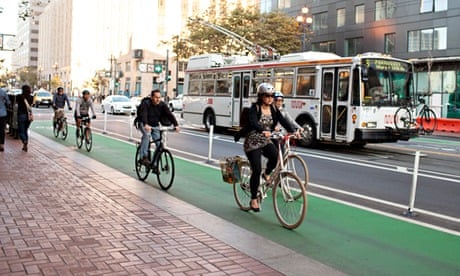Cities are driving the US economic recovery, and as they do, Americans are getting on their bikes. In 85 of the 100 largest metro areas cycling is increasing. All part of a deeply healthy – and profitable – reshaping of urban economies.
"Cities that invest in biking infrastructure are going to win," predicts Jeff Judge, a Chicago-based digital marketing entrepreneur, who said the presence of on-street protected bike lanes was his number-one factor in assessing a city to locate in. "It's better for business, planning, infrastructure. It's better all round."
After years of battling "the business community" for every inch of road space, many cycling advocates seem disoriented by the idea they might now be on the same side. But from Denver to Memphis, some of the loudest voices for a move toward Danish-style protected cycling infrastructure are those who sign the paychecks. In last month's report (PDF) for US non-profit People For Bikes, which I co-authored with Mary Lauran Hall of the Alliance for Biking and Walking, we outlined four reasons why:
Protected bike routes increase retail visibility and sales volume per parking space
When people use bikes for errands, they're the perfect customer: the kind that comes back again and again. They spend as much per month as people who arrive in cars, require far less parking and are easier to lure off the street for an impulse visit.
"If you're driving by at 35mph, you're not going to stop," said Wade Lange, vice-president of property management for Langley Investment Properties. With American Assets Trust, Lange's company was the leading advocate for converting two auto lanes into protected bike lanes in front of its $250m retail-and-apartments project in Portland, Oregon. "But you slow the traffic down, you do landscaping, you get more people walking, and suddenly the retail exists."

Protected bike routes make real estate more desirable
By extending the geographic range of non-car travel, bike lanes help urban neighborhoods to develop without waiting years for transit services. By calming traffic and creating an alternative to car lanes, protected bike lanes help to build the sort of neighbourhoods that people enjoy walking around.
H Street in Washington DC is a six-lane thoroughfare in a formerly run-down neighborhood, on which property manager Kathy Card made a big bet in 2005 by having her employer, Brookfield Office Properties, buy an office building there. Now, with the area booming and the property raking in cash, Card's main wish for H street is for protected bike lanes that would prevent her tenants' workers from needing "nerves of steel" to get to work, and to help her market the building to private-sector employers who'll pay a premium for a bike-friendly location.
Protected bike routes help companies score talented workers
Workers of all ages, but especially those who came of age after the 1990s urban crime plummet, increasingly prefer downtown jobs and homes. Protected bike lanes help employees to locate downtown without breaking the bank on parking space, and allow workers to reach their desk the way many like: under their own power.
"The ability to go walk and have lunch means a lot," said Ed Ireson, of the expanding technology company Mutual Mobile, which sees bike infrastructure as a way to remain in downtown Austin, Texas. "We'd rather cram into an office downtown than have plenty of breathing room out in the middle of nowhere."

Protected bike routes make workers healthier and more productive
By drawing clear, safe barriers between auto and bicycle traffic, protected bike lanes get more people in the saddle; burning calories, clearing the cobwebs and strengthening hearts, hips and lungs.
In the 1990s, big companies tried to keep workers healthy by adding on-site gyms. Now, some are realising that a few well-timed visits to city council meetings can turn the streets into an employee wellness programme.
Becky Bond, vice-president of San Francisco's Credo Mobile said: "Just like our employees have access to a gym and quality healthcare, we think that cycling can be an important benefit. We pay the premium to be downtown because it means our employees can enjoy the benefits of public transit and cycling to work."

Executives like Bond are dealing with young, progressive workers, and cycling has a long way to go before it becomes as mainstream as in northern Europe – the whole of the US still has fewer than 200 miles of protected bike lanes. But the sorts of stories documented in our report are the best hope that this is changing.
The future of cycling advocacy is one that European supporters have understood for years: it's in understanding that bicycle infrastructure isn't a luxury we splurge on if we think our economies can handle it. The truth is just the opposite: bicycle infrastructure is something we use to create wealth for our cities. It's something that helps us do all the other things our civilization needs.
Michael Andersen is staff writer for the People For Bikes Green Lane Project, which helps US cities to build better bike lanes. You can follow his infrastructure reporting on Facebook, Twitter or in a weekly email digest.
Join the community of sustainability professionals and experts. Become a GSB member to get more stories like this direct to your inbox

Comments (…)
Sign in or create your Guardian account to join the discussion